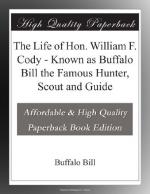During the afternoon and evening the gentlemen were all entertained at the post in a variety of ways, including dinner and supper parties, and music and dancing; at a late hour they retired to rest in their tents at the camp which they occupied outside the post—named Camp Rucker in honor of General Rucker.
At five o’clock next morning a cavalry bugle sounded the reveille, and soon all were astir in the camp, preparatory to pulling out for the first day’s march. I rose fresh and eager for the trip, and as it was a nobby and high-toned outfit which I was to accompany, I determined to put on a little style myself. So I dressed in a new suit of light buckskin, trimmed along the seams with fringes of the same material; and I put on a crimson shirt handsomely ornamented on the bosom, while on my head I wore a broad sombrero. Then mounting a snowy white horse—a gallant stepper—I rode down from the fort to the camp, rifle in hand. I felt first-rate that morning, and looked well.
The expedition was soon under way. Our road for ten miles wound through a wooded ravine called Cottonwood Canon, intersecting the high ground, or divide, as it is called, between the Platte and Republican Rivers. Upon emerging from the canon we found ourselves upon the plains. First in the line rode General Sheridan, followed by his guests, and then the orderlies. Then came the ambulances, in one of which were carried five greyhounds, brought along to course the antelope and rabbit. With the ambulances marched a pair of Indian ponies belonging to Lieutenant Hayes—captured during some Indian fight—and harnessed to a light wagon, which General Sheridan occasionally used. These little horses, but thirteen hands high, showed more vigor and endurance than any other of the animals we had with us. Following the ambulances came the main body of the escort and the supply wagons.
We marched seventeen miles the first day, and went into camp on Fox Creek, a tributary of the Republican. No hunting had as yet been done; but I informed the gentlemen of the party that we would strike the buffalo country the next day. A hundred or more questions were then asked me by this one and that one, and the whole evening was spent principally in buffalo talk, sandwiched with stories of the plains—both of war and of the chase. Several of the party, who were good vocalists, gave us some excellent music. We closed the evening by christening the camp, naming it Camp Brown, in honor of the gallant officer in command of the escort.
At three o’clock next morning the bugle called us to an early start. We had breakfast at half-past four, and at six were in the saddle. All were eager to see and shoot the buffaloes which I assured them we would certainly meet during the day. After marching five miles, the advance guard, of which I had the command, discovered six buffaloes grazing at a distance of about two miles from us. We returned to the hunters with this information, and they at once consulted with me as to the best way to attack the “enemy.”




